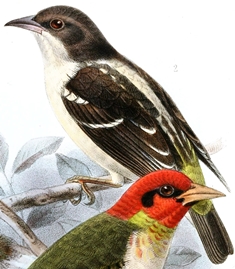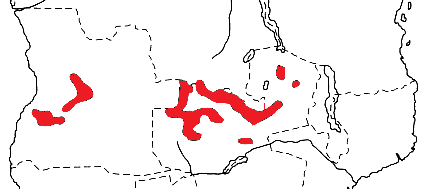Weaver Wednesday [83]: Bar-winged Weaver 2014-01-15 (473)
 Weaver Wednesday
Weaver Wednesday


The Bar-winged Weaver Ploceus angolensis is distinctive, not resembling any other weaver. The head is dark brown to below the eye, the back is brown and cream, the rump is yellow, and the underparts are white with a yellow wash on the belly. The wings are brown with two wing-bars, and it has a slender bill and short tail. The female resembles the male, but has less yellow wash on the underparts. The juvenile has a dull olive-grey crown, and paler bill.
The Bar-winged Weaver is one of several 'nuthatch' (bark-gleaning) weavers, the others being Brown-capped Weaver, Sao Tome Weaver, Preuss's Weaver, Usambara Weaver and Olive-headed Weaver. The Bar-winged Weaver does not overlap in range with any of these.

The Bar-winged Weaver occurs in miombo woodland from Angola to Zambia (see map left, based on Birds of Africa). No subspecies are recognised. It is not globally threatened, but is poorly known and uncommon within its relatively limited range.
The Bar-winged Weaver inhabits mature, tall Brachystegia woodland where it is moist enough to grow copious Usnea lichen on the trees. It also enters Cryptosepalum forest.
The Bar-winged Weaver is insectivorous, feeding on mantids, chironomid larvae, beetle larva, beetles and other insects. It forages by creeping along trunks, thin and thick branches covered with lichens and Usnea, continuously inspecting the wood for food. It forages in pairs and family parties, and often joins mixed-species flocks of insectivores.
The Bar-winged Weaver is a solitary, monogamous breeder. The nest is a roughly spherical ball with an entrance tube of length 30-210 mm hanging down from one side. The nest is constructed of Usnea, fine grass stems and a few narrow leaf midribs. It is suspended below a lichen-covered branch or from several slender twigs, around which the roof of the nest is woven. The nest is sited about 10m above the ground. It is built by both sexes,
one bird bringing material, the other inside the nest to weave and shape it. Two eggs are laid and they are turquoise-blue, obscurely flecked and clouded with a darker shade, mostly at the broad end.
There are no PHOWN records for the Bar-winged Weaver (see PHOWN summary). Submit any weaver nest records to PHOWN (PHOtos of Weaver Nests) via the Virtual Museum upload site.
PHOWN summary
Previous Wedn: Long-tailed Widowbird
Full weaver species list
|


 Weaver Watch
Weaver Watch


